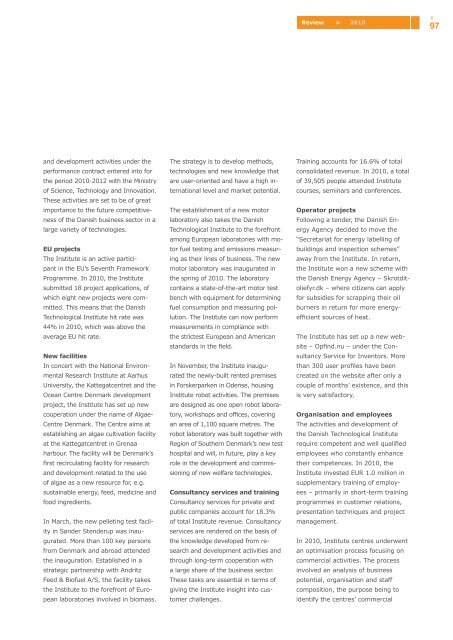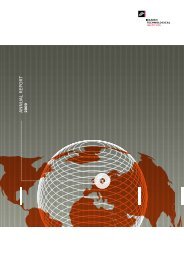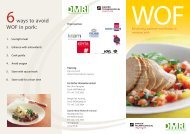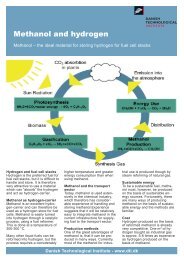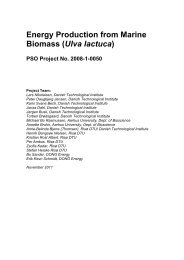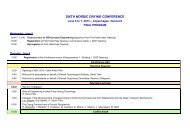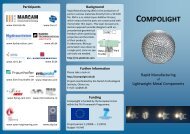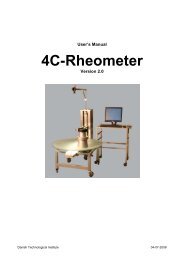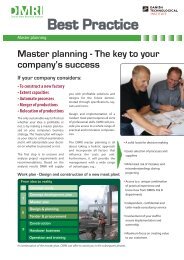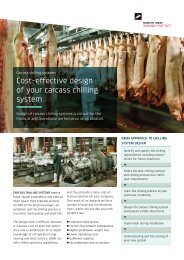Annual Report 2010 (4.1 MB) - Danish Technological Institute
Annual Report 2010 (4.1 MB) - Danish Technological Institute
Annual Report 2010 (4.1 MB) - Danish Technological Institute
Create successful ePaper yourself
Turn your PDF publications into a flip-book with our unique Google optimized e-Paper software.
Review > <strong>2010</strong><br />
97<br />
P.<br />
and development activities under the<br />
performance contract entered into for<br />
the period <strong>2010</strong>-2012 with the Ministry<br />
of Science, Technology and Innovation.<br />
These activities are set to be of great<br />
importance to the future competitiveness<br />
of the <strong>Danish</strong> business sector in a<br />
large variety of technologies.<br />
EU projects<br />
The <strong>Institute</strong> is an active participant<br />
in the EU’s Seventh Framework<br />
Programme. In <strong>2010</strong>, the <strong>Institute</strong><br />
submitted 18 project applications, of<br />
which eight new projects were committed.<br />
This means that the <strong>Danish</strong><br />
<strong>Technological</strong> <strong>Institute</strong> hit rate was<br />
44% in <strong>2010</strong>, which was above the<br />
average EU hit rate.<br />
New facilities<br />
In concert with the National Environmental<br />
Research <strong>Institute</strong> at Aarhus<br />
University, the Kattegatcentret and the<br />
Ocean Centre Denmark development<br />
project, the <strong>Institute</strong> has set up new<br />
cooperation under the name of Algae-<br />
Centre Denmark. The Centre aims at<br />
establishing an algae cultivation facility<br />
at the Kattegatcentret in Grenaa<br />
harbour. The facility will be Denmark’s<br />
first recirculating facility for research<br />
and development related to the use<br />
of algae as a new resource for, e.g.<br />
sustainable energy, feed, medicine and<br />
food ingredients.<br />
In March, the new pelleting test facility<br />
in Sønder Stenderup was inaugurated.<br />
More than 100 key persons<br />
from Denmark and abroad attended<br />
the inauguration. Established in a<br />
strategic partnership with Andritz<br />
Feed & Biofuel A/S, the facility takes<br />
the <strong>Institute</strong> to the forefront of European<br />
laboratories involved in biomass.<br />
The strategy is to develop methods,<br />
technologies and new knowledge that<br />
are user-oriented and have a high international<br />
level and market potential.<br />
The establishment of a new motor<br />
laboratory also takes the <strong>Danish</strong><br />
<strong>Technological</strong> <strong>Institute</strong> to the forefront<br />
among European laboratories with motor<br />
fuel testing and emissions measuring<br />
as their lines of business. The new<br />
motor laboratory was inaugurated in<br />
the spring of <strong>2010</strong>. The laboratory<br />
contains a state-of-the-art motor test<br />
bench with equipment for determining<br />
fuel consumption and measuring pollution.<br />
The <strong>Institute</strong> can now perform<br />
measurements in compliance with<br />
the strictest European and American<br />
standards in the field.<br />
In November, the <strong>Institute</strong> inaugurated<br />
the newly-built rented premises<br />
in Forskerparken in Odense, housing<br />
<strong>Institute</strong> robot activities. The premises<br />
are designed as one open robot laboratory,<br />
workshops and offices, covering<br />
an area of 1,100 square metres. The<br />
robot laboratory was built together with<br />
Region of Southern Denmark’s new test<br />
hospital and will, in future, play a key<br />
role in the development and commissioning<br />
of new welfare technologies.<br />
Consultancy services and training<br />
Consultancy services for private and<br />
public companies account for 18.3%<br />
of total <strong>Institute</strong> revenue. Consultancy<br />
services are rendered on the basis of<br />
the knowledge developed from research<br />
and development activities and<br />
through long-term cooperation with<br />
a large share of the business sector.<br />
These tasks are essential in terms of<br />
giving the <strong>Institute</strong> insight into customer<br />
challenges.<br />
Training accounts for 16.6% of total<br />
consolidated revenue. In <strong>2010</strong>, a total<br />
of 39,505 people attended <strong>Institute</strong><br />
courses, seminars and conferences.<br />
Operator projects<br />
Following a tender, the <strong>Danish</strong> Energy<br />
Agency decided to move the<br />
“Secretariat for energy labelling of<br />
buildings and inspection schemes”<br />
away from the <strong>Institute</strong>. In return,<br />
the <strong>Institute</strong> won a new scheme with<br />
the <strong>Danish</strong> Energy Agency – Skrotditoliefyr.dk<br />
– where citizens can apply<br />
for subsidies for scrapping their oil<br />
burners in return for more energyefficient<br />
sources of heat.<br />
The <strong>Institute</strong> has set up a new website<br />
– Opfind.nu – under the Consultancy<br />
Service for Inventors. More<br />
than 300 user profiles have been<br />
created on the website after only a<br />
couple of months’ existence, and this<br />
is very satisfactory.<br />
Organisation and employees<br />
The activities and development of<br />
the <strong>Danish</strong> <strong>Technological</strong> <strong>Institute</strong><br />
require competent and well qualified<br />
employees who constantly enhance<br />
their competences. In <strong>2010</strong>, the<br />
<strong>Institute</strong> invested EUR 1.0 million in<br />
supplementary training of employees<br />
– primarily in short-term training<br />
programmes in customer relations,<br />
presentation techniques and project<br />
management.<br />
In <strong>2010</strong>, <strong>Institute</strong> centres underwent<br />
an optimisation process focusing on<br />
commercial activities. The process<br />
involved an analysis of business<br />
potential, organisation and staff<br />
composition, the purpose being to<br />
identify the centres’ commercial


